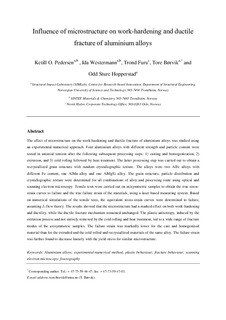| dc.contributor.author | Pedersen, Ketill Olav | |
| dc.contributor.author | Westermann, Ida | |
| dc.contributor.author | Furu, Trond | |
| dc.contributor.author | Børvik, Tore | |
| dc.contributor.author | Hopperstad, Odd Sture | |
| dc.date.accessioned | 2017-11-20T10:05:38Z | |
| dc.date.available | 2017-11-20T10:05:38Z | |
| dc.date.created | 2015-01-23T12:41:01Z | |
| dc.date.issued | 2015 | |
| dc.identifier.citation | Materials & Design. 2015, 70 31-44. | nb_NO |
| dc.identifier.issn | 0261-3069 | |
| dc.identifier.uri | http://hdl.handle.net/11250/2467107 | |
| dc.description.abstract | The effect of microstructure on the work-hardening and ductile fracture of aluminium alloys was studied using an experimental–numerical approach. Four aluminium alloys with different strength and particle content were tested in uniaxial tension after the following subsequent processing steps: (1) casting and homogenisation, (2) extrusion, and (3) cold rolling followed by heat treatment. The latter processing step was carried out to obtain a recrystallized grain structure with random crystallographic texture. The alloys were two AlFe alloys with different Fe content, one AlMn alloy and one AlMgSi alloy. The grain structure, particle distribution and crystallographic texture were determined for all combinations of alloy and processing route using optical and scanning electron microscopy. Tensile tests were carried out on axisymmetric samples to obtain the true stress–strain curves to failure and the true failure strain of the materials, using a laser-based measuring system. Based on numerical simulations of the tensile tests, the equivalent stress–strain curves were determined to failure, assuming J2 flow theory. The results showed that the microstructure had a marked effect on both work-hardening and ductility, whilst the ductile fracture mechanism remained unchanged. The plastic anisotropy, induced by the extrusion process and not entirely removed by the cold rolling and heat treatment, led to a wide range of fracture modes of the axisymmetric samples. The failure strain was markedly lower for the cast and homogenised material than for the extruded and the cold rolled and recrystallized materials of the same alloy. The failure strain was further found to decrease linearly with the yield stress for similar microstructure. | nb_NO |
| dc.language.iso | eng | nb_NO |
| dc.publisher | Elsevier | nb_NO |
| dc.rights | Attribution-NonCommercial-NoDerivatives 4.0 Internasjonal | * |
| dc.rights.uri | http://creativecommons.org/licenses/by-nc-nd/4.0/deed.no | * |
| dc.title | Influence of microstructure on work-hardening and ductile fracture of aluminium alloys | nb_NO |
| dc.type | Journal article | nb_NO |
| dc.description.version | acceptedVersion | nb_NO |
| dc.source.pagenumber | 31-44 | nb_NO |
| dc.source.volume | 70 | nb_NO |
| dc.source.journal | Materials & Design | nb_NO |
| dc.identifier.doi | 10.1016/j.matdes.2014.12.035 | |
| dc.identifier.cristin | 1205758 | |
| dc.relation.project | Norges forskningsråd: 237885 | nb_NO |
| dc.description.localcode | © 2014. This is the authors’ accepted and refereed manuscript to the article. This manuscript version is made available under the CC-BY-NC-ND 4.0 license http://creativecommons.org/licenses/by-nc-nd/4.0/ | nb_NO |
| cristin.unitcode | 194,64,45,0 | |
| cristin.unitcode | 194,64,65,0 | |
| cristin.unitname | Institutt for konstruksjonsteknikk | |
| cristin.unitname | SFI Structural Impact Laboratory | |
| cristin.ispublished | true | |
| cristin.fulltext | original | |
| cristin.qualitycode | 0 | |

